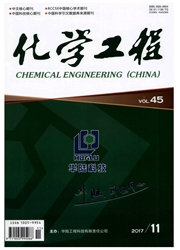

 中文摘要:
中文摘要:
为了研究疏水基底粗糙度对形核特性的影响规律,采用腐蚀及修饰的方法得到具有不同粗糙度的疏水基底,通过对基底表面粗糙度因子的计算和表观润湿角的测量,考察了基底粗糙度对基底表面水的表观润湿角的定量关系;在制备的粗糙基底上进行了冷凝蒸汽形核实验,利用统计方法得到基底粗糙度因子与冷凝液滴数量的关系。结果表明:基底微观形貌对水在基底表面的表观润湿性和形核特性具有显著影响,对于疏水基底,随着基底粗糙度的增加,水滴在其表面的表观润湿角增大;相同的基底过冷度下,越粗糙的基底表面蒸汽冷凝形核点越少。分析认为,基底微观形貌通过影响液胚在其表面的表观润湿角,进而改变异质形核功,造成了粗糙基底表面形核特性的改变。实验现象与基于Wenzel模型的粗糙基底异质形核理论取得了一致。
 英文摘要:
英文摘要:
The hydrophobic glass substrate surfaces with different roughness were prepared by eroding and decorating. The wetting behaviors of these rough surfaces and the condensing nucleation characteristics of water vapor on them were investigated experimentally. The experimental results indicate that the surface micro-morphology has significant influences on the wettability and condensing nucleation properties on these rough surfaces; the apparent wetting angle increases with the increase of surface substrate roughness, while the nucleation density of water droplets on the hydrophobic coarse glass surface decreases. The analysis suggests that the effect of surface microstructure on apparent wetting angle leads to the change of nucleation energy and nucleation density, that is, a larger apparent wetting angle forms on a rougher hydrophobic surface, which leads to the increase of free energy needed for heterogeneous nucleation and the decrease of nucleation density of vapor condensation. The condensation experiments on hydrophobic rough substrates agree with the previous theoretical description for heterogeneous nucleation on rough surfaces.
 同期刊论文项目
同期刊论文项目
 同项目期刊论文
同项目期刊论文
 The effect of 3-dimensional shear flow on the stability of a crystal interface in the supercooled bi
The effect of 3-dimensional shear flow on the stability of a crystal interface in the supercooled bi The effect of two-dimensional shear flow on the stability of a crystal interface in a supercooled me
The effect of two-dimensional shear flow on the stability of a crystal interface in a supercooled me Linear stability analysis on a spherical particle growing from a binary melt under the far-field flo
Linear stability analysis on a spherical particle growing from a binary melt under the far-field flo Effect of intermediate heat treatment temperature on microstructure and notch sensitivity of laser s
Effect of intermediate heat treatment temperature on microstructure and notch sensitivity of laser s 期刊信息
期刊信息
